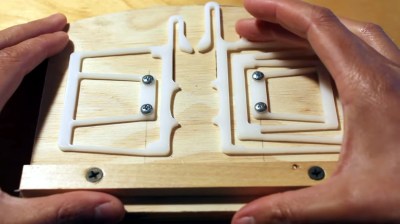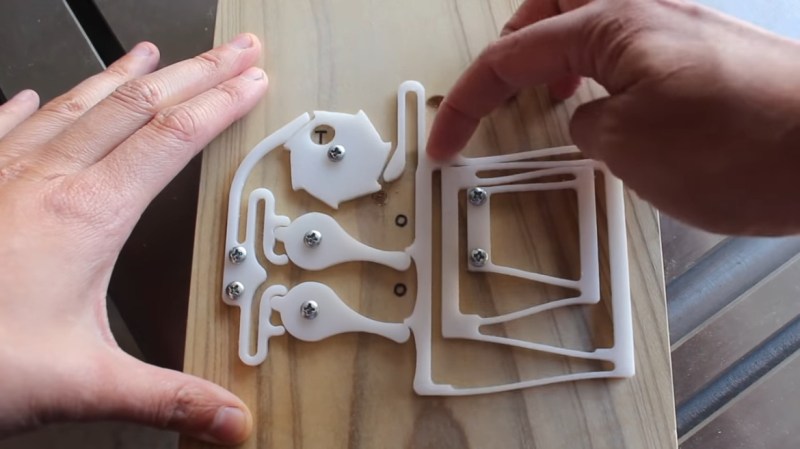When we met [Amy Makes Stuff] at the 2019 Hackaday Superconference, we were immediately impressed with the array of flexure mechanisms displayed on a board hanging around her neck. That must be where we saw [Amy]’s original version of the cat calendar — a simple way to know for sure whether the shared house’s cat has been fed once, twice, or not at all on a given day.

Awesome as it is, the flexure mechanism doesn’t reset the yes/no indicators when the day clicks over — that has to be done manually. So when [Amy] was offered to try a small desktop CNC, she decided it was time to make a new version that resets automatically. Check it out in the video after the break, which also includes an exploration of [Amy]’s choice of flexure design as well as a bonus review of the CNC.
This is just an all-around great video, especially after [Amy] neglected to mill out the check marks and circles, sending her down a rabbit hole of attempting to make branding bits for these that could be chucked into a soldering iron. Unfortunately, the mill stops short of having the necessary mettle for milling metal.
Although [Amy] is likely known for her flexures, she has a ton of skills. Remember when she resurrected that burned and bubbled laser cutter? Or the time she machined a honing jig for hand-sharpening chisels and planes?
















Nice to see a video without gesticulating monkey like the videos of many youtubers. It´s a decent and simple demonstration. Refreshing !
I swear you guys have me bugged or something … I watch a video and like the very next day there’s an article posted here about it lol!
know about apophenia ? https://en.wikipedia.org/wiki/Apophenia
If you think that these are unrelated events then you may be suprised if you look into how the recommendation systems work nowadays.
That’s such a clean and sharp looking device, those flextures are amazing work.
Although the ball-nose end mill is fine for the finger slot, I think it was the wrong choice for the flexture plate. The sharp flute tips of a regular end mill are going to cut better on its end (obviously) and would be even more necessary for the aluminium.
That’s really not true at all, ball endmills all have perfectly good cutting geometry, and create much less pressure on contact because they are only contacting at a point compared to the full diameter of the cutter.
Most complex shapes in machining are done with 3D cutting paths traced with ball endmills at high speed for a reason.
I was extremely disappointed at this machine that it couldn’t even handle basic brass that is absolutely pathetic I mean brass is basically the easiest material in the world to cut among metals. If it can’t handle brass- it’s practically garbage. Even aluminum is really not much more difficult to cut.
Her question about the mechanism warping- I guarantee that is not from taking it off the bed but stress inside the material itself, also an extension of the heat generated by cutting that slowly stressing the edges of the part. I used to do plastics & composites for about 3 years, plastic has way more stress in it than most realize.
The key to keeping it from warping is removing the material equally from as many sides as possible. A big way to do that is skimming equal stock off top & bottom of your sheets before cutting the final height of the part- ideally doing it in several steps. This releases the internal stresses a great deal from the pressed surfaces as they were extruded. Using compressed air to keep the cut cool makes a huge difference as well.
She did accidentally what I used to do by default using a vaccum table- cut to within 0.01-0.005″ of the table top, leaving a translucent skin and then taking the part off and deburring with a razor blade (or Shaviv tool) to bring the part to finish.
The flexture design though was very cool! I would like to see more on hackaday on flexture design and if there are any textbooks that cover it
The issue isn’t the machine, it’s the rubbish milling bits. My CNC3018 happily cuts steel with a proper professional bit (even one that’s been thrown out as ‘used’ by a local engineering company), whereas the cheap Chinese mills sold online barely cut wood.
It’s also the machine. Look at ~7:54 where the stiffness (in z) is clearly shown to be inadequate. I would never even attempt to cut steel with my crappy chinese CNC3018.
Enough of cats! Is there something like this that can keep track of dog feedings?
B^)
Never enough cats…
Simpler solution is not to have pets. After having rabbit, dog and a cat at my parents home I finally realized how inhumane that is – even despite the best care taken.
Why is it inhumane? If you don’t feed, water, and walk them then you are right. However, if you care about your family members, yes I mean animals, then both of your lives can be enriched. I’m sorry, you have had such poor experiences with animals. Or it could just be your parents…🤔
I’d highly recommend going to a 2-flute cutter for everything except the steel.
And as mentioned above, rigidity is everything when it comes to CNC cutting. You’re much better off converting a mill to CNC than getting one of these little desktop cutters.
I like the no-nonsense presentation style as well as the discussion of the failed parts of the project.
I wonder if she would be willing to provide the files.
In place of double side tape there is a much better solution!
https://www.gravostoreusa.com/eng/product/78056
Use it daily on my home CNC
Most cats eat small amounts at short intervals and also; most cats will not eat more than necessary. My cat calender is simple: fill bowls when (nearly) empty. It has always worked (i.e. no obese cats) I’ve had cats for half a century now, varying between two to now well over sixty at the refugio I run.
The device described, however, could be very handy in situations where illness dictates diets and mealtimes.
Depends a lot on the cat. Like humans, stresses affect behavior. My cat has never had a problem with over eating, neither had my sister’s cats. But when her cat became diabetic, and had her diet restricted, kitty decided that the reduced amount of food available meant the world was ending and every meal needed to be scarfed down as quickly as possible. Mix in the hunger from insulin, and the stress of injections, and “normal” behavior can change quickly.
And what stresses the pets might not be noticeable to the humans. A new animal next door making noises, or strange smells, new traffic sounds. A new wild animal moving around outside. What a pet considers normal versus what they consider a threat isn’t always comprehensible to humans.